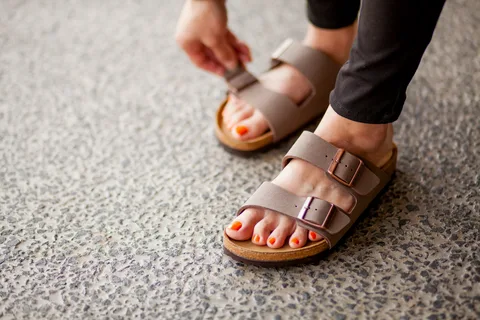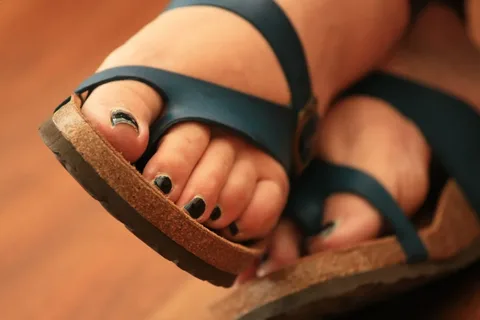Do you suffer from bunions? Bunions can cause serious discomfort and sometimes lead to more complex issues. The good news is that there are plenty of ways to take care of your feet and manage the symptoms of bunions. One of the best things you can do is find the right bunion sandals. In this blog post, we’ll look at the best shoes for people with bunions so you can take care of your feet and keep them happy and healthy.
What are Bunions and How they Affect Footwear Choices?
Bunions, those bumpy protrusions at the base of your big toe, can be quite a nuisance. But what exactly are they, and why do they affect your choice of footwear? Well, let’s dive in and find out. Bunions are a condition characterized by the misalignment of the joint at the base of the big toe. They often develop due to genetics, foot structure, and improper footwear. As the bunion grows, it can cause the big toe to push against the other toes, leading to discomfort, pain, and difficulty finding comfortable shoes.
So, how do bunions affect your choice of footwear? The misalignment of the big toe joint means that certain shoes can exacerbate the problem. Tight, narrow, and pointy-toed shoes can squeeze the toes together, putting pressure on the bunion and causing pain. It’s crucial to find footwear with a roomy toe box that allows your toes to spread naturally, relieving the pressure on the bunion. Now that we understand what bunions are and how they affect footwear choices let’s explore the factors to consider when selecting bunion-friendly footwear. Stay tuned!
Factors to Consider When Choosing Bunion-Friendly Footwear
When choosing footwear for bunion sufferers, several important factors must be considered.
- You’ll want to prioritize comfort. Look for shoes that provide ample cushioning and support for your feet. This will help alleviate pressure on your bunions and prevent further discomfort.
- Consider the toe box. Opt for shoes with a spacious toe box that allows your toes to spread naturally. Avoid narrow or pointy-toed shoes that squeeze your toes together, putting unnecessary pressure on your bunions.
- Another factor to keep in mind is adjustability. Look for shoes with adjustable straps or laces, as these can accommodate any swelling or changes in foot size throughout the day.
- Choose shoes with a low heel or no heel at all. High heels can place excessive pressure on the balls of your feet and worsen bunion pain.
- Consider the materials of the shoes. Look for options made of breathable materials that allow for good air circulation, as this can help prevent excessive sweating and potential skin irritation.
Considering these factors, you can find bunion-friendly footwear that provides comfort, support, and relief for your feet. Remember, investing in the right shoes can make a difference in managing your bunion symptoms.
Top Tips for Finding the Right Bunion Sandals
When finding the right bunion sandals, remember a few key tips. First, look for sandals with a roomy toe box that allows your toes to spread naturally. This will help alleviate pressure on your bunions and provide a more comfortable fit. Adjustable straps are also essential, as they allow you to customize the fit and accommodate any swelling or changes in foot size throughout the day. Use sandals with ample cushioning and support to relieve and prevent further discomfort.
Look for options with contoured footbeds and arch support to help distribute weight evenly and reduce pressure on the bunion. Materials also matter – choose sandals made of breathable materials that allow for good air circulation to prevent excessive sweating and potential skin irritation. Lastly, consider sandals with a low heel or no heel, as high heels can exacerbate bunion pain. By following these top tips, you’ll be well on your way to finding the perfect sandals that prioritize both style and comfort for your bunions.
The Best Shoe Styles for Bunions: From Sneakers to Sandals
When it comes to finding the best shoe styles for bunions, it’s all about finding the perfect balance between comfort and style. Sneakers and sandals are two popular options that can relieve your bunions while keeping you looking fashionable. Let’s start with sneakers. Look for a spacious toe box to allow your toes to spread naturally and relieve pressure on your bunions. Opt for sneakers with ample cushioning and arch support to provide comfort and stability. Additionally, adjustable laces or straps can help customize the fit and accommodate any swelling throughout the day.
Now, let’s move on to sandals. Look for options with a roomy toe box and adjustable straps to ensure a comfortable fit. Sandals with contoured footbeds and arch support can help distribute weight evenly and reduce pressure on your bunions. Choose materials that are breathable to prevent sweating and potential skin irritation. Remember, finding the best shoe styles for bunions prioritizes comfort and support. With the right pair of sneakers or sandals, you can keep your feet happy and healthy while staying on-trend.
How to Wear Your Favorite Shoes without Causing Bunion Pain?
Wearing your favorite shoes doesn’t have to be a painful experience, even if you suffer from bunions. You can still enjoy stylish footwear with a few tricks and adjustments while minimizing bunion pain. Here’s how:
Choose the right size:
Make sure your shoes fit properly, with enough room in the toe box to accommodate your bunions. Avoid shoes that are too tight or narrow, as they aggravate your condition.
Use shoe stretchers:
If you have a favorite pair of shoes that are slightly too tight, invest in shoe stretchers. These handy devices can help widen the toe box, providing more room for your bunions.
Use orthotic inserts:
Custom orthotic inserts can provide additional support and cushioning for your feet, reducing pressure on your bunions. Look for inserts specifically designed for bunion relief.
Stretch your shoes:
Another trick to make them more comfortable is to stretch them using a shoe stretching spray or wearing thick socks. This can help loosen the material and provide relief for your bunions.
Avoid high heels:
High heels can put excessive pressure on the balls of your feet, exacerbating bunion pain. Opt for lower-heeled shoes or flats instead.
By following these tips, you can continue to wear your favorite shoes without causing additional bunion pain. Remember, comfort should always be a priority regarding your footwear choices.
Tricks for Easing Pain and Discomfort
If you’re suffering from bunions, you know that pain and discomfort can become a regular part of your life. Luckily, there are some tricks you can try to ease the pain and make your feet more comfortable. Consider using ice therapy. Applying an ice pack or even a bag of frozen peas to your bunions can help reduce inflammation and numb the area, providing temporary relief. Another trick is to use over-the-counter pain relievers like ibuprofen or acetaminophen to manage the discomfort.
You can use bunion pads or cushions to provide extra padding and protection to your bunions, preventing them from rubbing against your shoes. Another effective method is to soak your feet in warm water with Epsom salts. This can help relax your muscles and reduce inflammation. Finally, take into account the power of stretching exercises. Gentle stretching can help alleviate tension in your feet and promote flexibility. You can relieve bunion pain and discomfort by incorporating these tricks into your daily routine.
The Dos and Don’ts of Bunion Care
When it comes to bunion care, there are certain dos and don’ts that you should keep in mind to ensure you’re giving your feet the best possible treatment. Let’s dive in and explore these important guidelines.
Wear bunion-friendly footwear:
Opt for shoes with a roomy toe box, ample cushioning, and arch support to provide comfort and alleviate pressure on your bunions.
Do use orthotic inserts:
Custom orthotic inserts can offer additional support and cushioning, reducing discomfort and preventing further aggravation of your bunions.
Do practice foot exercises:
Gentle stretching and strengthening exercises can help improve the flexibility and function of your feet, alleviating tension and promoting better foot health.
Do use ice therapy:
Applying an ice pack to your bunions for 15-20 minutes several times a day can help reduce inflammation and numb the area, providing temporary relief.
Don’t wear tight or narrow shoes:
Avoid footwear that squeezes your toes together, as this can worsen bunion pain and discomfort.
Don’t wear high heels:
High heels put excessive pressure on the balls of your feet, exacerbating bunion symptoms. Opt for lower-heeled shoes or flats instead.
Don’t ignore your bunion:
It’s important to address bunion discomfort early to prevent further progression and potential complications. Consult with a healthcare professional for proper diagnosis and treatment options.
Pay attention to overall foot health:
Take care of your feet by keeping them clean, moisturized, and well-groomed. Regularly inspect your feet for any changes or abnormalities.
FAQs
Can bunions be cured?
Unfortunately, there is no cure for bunions. However, you can manage the symptoms and prevent them from worsening by wearing the right footwear and practicing good foot care.
Can I still wear heels if I have bunions?
While high heels can worsen bunion pain, you don’t have to give up heels altogether. Opt for lower-heeled options that provide more support and don’t put as much pressure on the balls of your feet.
Do I need to see a doctor if I have bunions?
If your bunions are causing severe pain or impacting your daily life, consulting with a healthcare professional is a good idea. They can diagnose accurately, offer treatment options, and recommend necessary lifestyle changes.
Conclusions
In the world of bunion woes, finding the right footwear can make all the difference. We’ve explored the ins and outs of bunions and how they affect your shoe choices. We’ve covered everything from understanding the factors to consider when selecting bunion-friendly footwear to discovering the best shoe styles for bunions. We even shared tips for finding the right bunion sandal and wearing your favorite shoes without causing bunion pain.
| Other Good Articles to Read |
| Skank Blogs |
| Unreal Blogs |
| Tba Blogs |
| All City Forums |
| Dany Blogs |
| Refuge Blogs |
| The Music Blogs |
| Key Forums |
| The Big Blog Theory |
| Joe Blogs |
| Blogs 4 Me |
| Blogs Emon |



